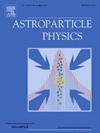Gamma-ray background from rock: Studies for a next-generation dark matter experiment based on liquid xenon
IF 2.9
3区 物理与天体物理
Q1 ASTRONOMY & ASTROPHYSICS
引用次数: 0
Abstract
Rare event experiments, such as those targeting dark matter interactions and neutrinoless double beta (0) decay, should be shielded from gamma-rays that originated in rock. This paper describes the simulation of gamma-ray transport through the water shielding and assessment of the thickness needed to suppress the background from rock down to a negligible level. This study focuses on a next-generation xenon observatory with a wide range of measurements including the search for Weakly Interacting Massive Particles (WIMPs) and 0 decay of 136Xe. Our findings indicate that the gamma-ray background is unlikely to persist through analysis cuts in the WIMP energy range (0 - 20 keV) after 3.5 m of water, complemented by 0.5 m of liquid scintillator. For 0 decay, a background below 1 event in 10 years of running can be achieved with a fiducial mass of 39.3 tonnes. Furthermore, for typical radioactivity levels of 1 Bq kg−1 of 232Th and 238U we have studied the effect of reducing the water shielding by 1 m, resulting in a reduced fiducial mass of 19.1 tonnes for 0 decay and still a negligible background for WIMP search. The paper also presents the measurements of radioactivity in rock in the Boulby mine, which hosted several dark matter experiments in the past and is also a potential site for a future dual-phase xenon experiment. The measurements are used to normalise simulation results and assess the required shielding at Boulby.
来自岩石的伽马射线背景:基于液态氙的下一代暗物质实验研究
罕见事件实验,比如那些针对暗物质相互作用和中微子双β (0νββ)衰变的实验,应该屏蔽来自岩石的伽马射线。本文描述了伽马射线通过水屏蔽传输的模拟,并评估了将背景从岩石抑制到可忽略的水平所需的厚度。这项研究的重点是下一代氙天文台,它具有广泛的测量范围,包括寻找弱相互作用大质量粒子(wimp)和136Xe的0νββ衰变。我们的研究结果表明,在3.5 m的水和0.5 m的液体闪烁体的补充下,通过分析WIMP能量范围(0 - 20kev)的削减,伽马射线背景不太可能持续存在。对于0νββ衰变,在基准质量为39.3吨的情况下,在10年的运行中可以实现低于1个事件的背景。此外,对于典型的放射性水平为1 Bq kg−1的232Th和238U,我们已经研究了将水屏蔽减少1 m的影响,导致0νββ衰变的基准质量减少19.1吨,并且仍然可以忽略WIMP搜索的背景。论文还介绍了Boulby矿中岩石放射性的测量结果,该矿过去曾举办过几次暗物质实验,也是未来双相氙实验的潜在地点。测量结果用于规范化模拟结果并评估Boulby所需的屏蔽。
本文章由计算机程序翻译,如有差异,请以英文原文为准。
求助全文
约1分钟内获得全文
求助全文
来源期刊

Astroparticle Physics
地学天文-天文与天体物理
CiteScore
8.00
自引率
2.90%
发文量
41
审稿时长
79 days
期刊介绍:
Astroparticle Physics publishes experimental and theoretical research papers in the interacting fields of Cosmic Ray Physics, Astronomy and Astrophysics, Cosmology and Particle Physics focusing on new developments in the following areas: High-energy cosmic-ray physics and astrophysics; Particle cosmology; Particle astrophysics; Related astrophysics: supernova, AGN, cosmic abundances, dark matter etc.; Gravitational waves; High-energy, VHE and UHE gamma-ray astronomy; High- and low-energy neutrino astronomy; Instrumentation and detector developments related to the above-mentioned fields.
 求助内容:
求助内容: 应助结果提醒方式:
应助结果提醒方式:


